
Hamilton Falconwatch 2005 News Reports
SUMMER 2005 - FLYING ON THEIR OWN

July 20, 2005: Lead Monitor Audrey Gamble reports: Although the official HNC Falconwatch '05 came to a successful end on July 8, there is still a lot of fun falconwatching to be had in downtown Hamilton. Adults Madame X and Newbie did a bit of 'redecorating' in the nest ledge after the youngsters moved out. They do this each season at this time just to tease Falconwatchers into thinking that we may have a second brood of babies and an autumn Falconwatch. HmmmÖ.come to think of it, the fall weather might be more agreeable! Adults and youngsters can still be spotted at the nest ledge once in a while.
All three juveniles continue to thrive and have reached a breathtakingly beautiful stage in their development. Although they are ranging farther afield in their hunting expeditions they usually settle in somewhere close to the old Sheraton homestead to spend their nights. They continue to entertain with their aerobatic play, pilfering food from one another and taking pot shots at the local gulls. You can often hear the youngsters as they sport and cavort around the sky. We often see them perched on aerials atop the nearby apartment buildings to the west of Bay St. and tall buildings east of James St. It's nice to see them staying high and out of mischief.
The adults can still be seen close by, keeping an eye on the juveniles and often accompanying their offspring on excursions. On Sunday afternoon HCPP volunteers were lucky enough to see Anson and Newbie return from a successful hunt. While we weren't sure who had bagged the quarry we could only admire Anson's plucking skills and healthy appetite! Coordinator Lee Roy has visited Hamilton a couple of times since the end of Falconwatch and has to take our word for it that there are peregrines in Hamilton as she always seems to just miss them.
July 7, 2005 - Lead Monitor Audrey Gamble reports: On the last official night of Falconwatch 2005 we were entertained by a demonstration of the skills the youngsters are honing on their road to independence. The young birds continue to perch close together and interact like siblings, especially when food is involved, Lancaster more of a loner than her brother and sister. More than once the youngsters chased and dove after prospective meals. All fly well with clean, adult-like 'upswoop' landings. They are gaining more height in their climbs, more speed on their dives and better maneuverability and braking power too! The adults continue to drop food off for the youngsters, but are careful not to get caught in the crossfire. The youngsters continue to learn and practice their skills, by what can only be termed playing. When they land on rooftops they explore and clamber up and down on things, not unlike behaviour you would expect of your pet budgie. Harvey picked up an abandoned carcass on the Fairclough rooftop and practiced plucking and moving around with it in his talons; a sort of combination tango and drum solo which had us laughing out loud. As regal and impressive as they are in the air the youngsters are so beguilingly funny on foot.
Again the evening hours saw six peregrines in the downtown core; alas not the six we had in mind, but awe inspiring and precious still. Madame X and Newbie pulled in the welcome mat and escorted the stranger on his way with choice words. From now until the young birds leave the area in August or September there will be lots of interesting antics to watch, so keep your head up when you're downtown. You never know who you'll see!
Thanks to Coordinator Lee Roy, our fabulous volunteers, and everyone in the Hamilton communities and in the webworld for supporting our work in so many ways. HCPP volunteers continue to keep an eye on the birds informally and welcome reports of sightings year round. In particular if you have clear sightings of bands or a one-footed falcon (guess who) please pass them along. We will continue to provide updates from time to time as news comes our way.
July 6, 2005 - Falconwatch Coordinator Lee Roy reports: Seeing a ghost, or an intruder? Today for the first time since June 26 six (6) Peregrine Falcons could be seen at the same time. The only chick in view was sitting on the Sheraton camera when a commotion broke out over Standard Life. Suddenly there were 5 birds in the air and one still on the camera. There was a lot of noise and chasing as both of the adults escorted the intruder out of their territory. With the trespasser gone Madame X and Newbie noisily scouted the area and eventually landed on the nest ledge. Whether the sixth Peregrine was an adult from the Skyway Bridge nest site or was Dundas returning for a visit could not be determined.
It has been confirmed that at least one of the chicks is hunting!! At 7:08 this morning both adults and two chicks were in sight. The third chick, likely Lancaster, landed not far from the others with food. She was 'encouraged' to share her small snack with her siblings.
July 5, 2005 - Falconwatch Coordinator Lee Roy reports: Today the juveniles were out of sight! Really!! For the most part the fledglings were not seen by falconwatchers during the early morning and evening watches. For only a brief time could the whole family of five be located, before in ones and twos they flew off in different directions.
At 20:45 Newbie was seen making a very small food drop to two of the chicks on the Standard Life building. That brought in Lancaster from her usual nighttime perch on the Stelco tower. Madame X was eating a large pigeon for over 40 minutes on the Sheraton; she was not seen feeding the chicks and there was no indication that she had offered it to them. The chicks even left her alone with it. A break for her!
July 4, 2005 - Falconwatch Coordinator Lee Roy reports: As the juveniles venture farther from the nest site they become harder to observe. While none of the young Peregrines have been seen taking prey there are many indications that they are doing some hunting on their own. Each of the chicks has been seen chasing smaller birds; Lancaster has even gone after a couple of gulls. Harvard was seen carrying quite a large bird. Tonight Anson was observed taking food from Madame X on the wing. The adults have been feeding the juveniles less often, forcing them to find food on their own. Since the chicks have been venturing farther it is impossible to know what they are doing. When the chicks are in sight of falconwatchers they appear very confident, and their flight skills are approaching those of the adults. Start looking up as you move around town, these chicks are flying farther everyday!
July 3, 2005 - Falconwatch Coordinator Lee Roy reports: First there was one, then suddenly all three juveniles were in the air screaming and chasing one another. The leader made a nice dive into a flock of pigeons and stayed with them while its nest mates followed into the thick of things. Soon the three were playing tag amongst the pigeons. I'm sure the pigeons were impressed, falconwatchers sure were. Later in the evening one of the juveniles pursued a single pigeon, and almost caught it!!
Each day the young falcons are showing their independence and testing their abilities. As they become more confident and proficient with their new skills they will venture farther afield. Newbie and Madame X have been sitting nearby, watching their chicks develop and progress toward truly being on their own.
July 2, 2005 - Falconwatch Coordinator Lee Roy reports: Compared with yesterday's activities, today was pretty quiet. The juveniles made some short flights this morning, but nothing particularly noteworthy. Madame X and Newbie brought each chick its own meal, so there was no need for them to fly around looking for a parent. After being fed the youngsters found shaded areas and settled in for the day. Falconwatchers passing through downtown reported seeing some mid-day activity, but for the most part they remained hidden.
This evening all three were quite active - talon touching, bumping and generally chasing each other around the Sheraton area. They were playing, and in doing so honing their hunting and flying skills. It won't be long now before we know for sure that a juvenile has caught food on its own.
July 1, 2005 - Falconwatch Coordinator Lee Roy reports: What a show!! And I don't mean the Canada Day fireworks. This evening, just as it seemed the chicks were settling down for the night, Harvard came into view flying quite steadily and carrying a rather impressive piece of food. Anson and Lancaster decided he was going to 'share' his food with them. Suddenly there was a flurry of feathers as all three birds were in the air, engaged in a serious game of chase. They swirled around the parking lot, over the Sheraton, between the buildings and then dove toward Bay Street. Two of the juveniles reemerged and landed back on the Standard Life building. A rescue team was quickly deployed since in case something had happened to the third bird, but Lancaster was safe and sound on another building, looking down at the food that Harvard had dropped on the road. The food was quickly removed to prevent any of the chicks from coming down into the traffic. Whether or not Harvard had actually captured this on his own or received a transfer from one of the parents is not known.
Today wraps up the dawn-to-dusk portion of the 2005 Hamilton Community Peregrine Project Falconwatch. The juveniles will still be monitored in the morning and evening, but during the day they will be on their own. They are flying well enough that they don't need constant observation. We will be present during the times of day when they are most active should they need our help, and daily reports will continue for a while.
June 30, 2005 - With Falconwatch Coordinator Lee Roy taking a well-deserved day off, the chicks were gentle on the volunteers. The three juveniles came together for breakfast on the roof of the Standard Life building around 08:30 and stayed close by all morning, except for the odd short excursion. However, at the height of the day's heat and humidity from noon until about 18:00, it was hard to find more than one youngster at a time. The 'girls' spent most of the afternoon hiding behind the grating at the very top of the Stelco building, with only the occasional wing-flap betraying their hiding place. Harvard was more visible, taking a long flight high enough that he could be followed over most of the downtown area. At one point he stooped from a good height into a flock of pigeons, but without causing any harm other than scattering and certainly scaring them.
Normally the falcons take off by dropping away from whatever perch they are on. Lancaster has an interesting variation on this - on several occasions she has been seen 'helicoptering', lifting off straight up for several feet before moving forward. While lifting off a few inches is common, long-term volunteers donít recall ever seeing a chick continue to rise and then fly from such a start. Before settling down for the night the fledglings did some talon touching and followed mom and dad around a bit.
June 29, 2005 - Falconwatch Coordinator Lee Roy reports: Falconwatchers are frequently asked how they manage to tell the chicks apart. The answer isn't easy; a combination of appearance and behaviour are the main clues.
Harvard is the 'easiest' to identify. First, he is smaller than his sisters. Second his feet are a pale blue grey; this is unusual, Peregrine feet are usually bright yellow. He seems to enjoy being the annoying little brother. When his sisters are sitting on the edge of something he'll buzz past and try to knock them off their perch. He is progressing very nicely. At mid-afternoon today falconwatchers were treated to show as Harvard caught a thermal and rode it up till he was almost out of sight. He then dove back to ground and made a really beautiful landing.
Anson is the largest of all the chicks. She has rather wide malar stripes - the black bars that run down the side of a falcon's face just under the eyes - and her head is rather dark. Anson and Harvard are frequently seen near each other, so it is easy to compare their sizes. Anson was observed a couple of days ago exploring a rooftop where she found an eye-hook. She proceeded to practice her attack technique on the hook. She held it down with one foot and beat at it with her beak till she was certain she had 'killed' the offending object.
Lancaster has been dubbed the 'Blond Bomber' by watchers. She has very pale buff markings on her head, very thin dark malar stripes and dark 'mascara' markings that end on the back of her head in a point. She is most often alone, which makes it difficult to judge her size compared to her siblings. When you see her in the air you would be hard pressed to tell that Lancaster was the last of the chicks to fly. She maneuvers like she was made to do only one thing!!! Lancaster is also a feisty beast - yesterday she chased a gull between the Sheraton and Stelco tower!
June 28, 2005 - Falconwatch Coordinator Lee Roy reports: Falconwatchers have been very protective of Harvard, Anson and Lancaster these past three days, and understandably so! Trying to be sure of the location of each chick at all times is becoming an impossible task. The young falcons are learning their independence and starting to venture farther from sight. Anson disappeared, heading east, at 6:30 this morning and was 'missing' all day. Several extensive searches of the downtown area failed to locate her, but there was nothing to panic about since this is all part of becoming independent. We suspected that she had gone adventuring on her own, or with an adult. Twelve hours later, while Madame X and Newbie were in the sky playing tag with the other two chicks, falconwatchers located Anson safe and sound on the roof of the HSBC building. Anson moved from building to building during the evening but settled down for the night in the nest ledge with Harvard. Lancaster again spent the night on the Stelco tower; she is apparently quite comfortable there. Harvard and Lancaster are flying very nicely. Their flights are getting longer and each seems stronger than the last. They are gliding with ease and landing solidly. Newbie took them both for a 'spin' around the parking lot, treating watchers to the wonderful aerobatics that only Peregrines are capable of.
June 27, 2005 - Falconwatch Coordinator Lee Roy reports: After yesterday's sad events Madame X and Newbie still seem to be looking for Canso but are not neglecting their other chicks.
All three juveniles started the day on the Sheraton. One by one they decided to leave their hotel 'room' to explore downtown. Anson found a comfortable window ledge on which to nap during the heat of the day, but as evening approached she sought a better view atop the Stelco tower. Harvard also spent a good deal of the day on Stelco, but around lunchtime he thought it best to head back to the hotel. He was disappointed to find that 'room service' would not arrive until 18:10. Lancaster got up early and looked for breakfast on the roof of the Standard Life building. She then made her way back to the hotel where she stayed in 'bed' until almost noon. When she did reemerge she explored every nook and cranny on the roof of the Fairclough building, and eventually made a gorgeous flight to the top of the Stelco tower - her landing was superb.
During the evening the three chicks got together on the Stelco tower where they enjoyed appetizers. For the main course they moved over to the CIBC building where Madame X was serving up a hearty meal. After dinner there was much flapping and some nice flights by all the youngsters. Madame X and Newbie invited the chicks to fly with them but got no takers. It seemed that the day had worn them all out and each found a restful spot for the night. Anson and Harvard returned to the nest ledge. Lancaster decided she had spent enough time in the scrape and went to spend the night on the Stelco tower.
June 26, 2005 - Falconwatch Coordinator Lee Roy reports: Our youngest has finally flown!! At 05:50 this morning, shortly after sunrise, Lancaster was standing on the ledge when she stretched her wings out and just stepped off!! She did a graceful first flight over the art gallery then landed beautifully on the roof of the Sheraton - where she stayed for the rest of the day.
Unfortunately Lancaster's first flight fell into the shadow of her oldest brother's death. Sadly, Canso collided with a window on the south side of the Standard Life building around 09:00 this morning and was killed. Canso, Harvard and Anson were involved in a game of chase with Newbie when the accident happened. Falconwatchers will continue to monitor the remaining three juveniles while they mourn the loss of Canso. We have been fortunate - of 33 chicks in the eleven years Peregrines have been nesting in downtown Hamilton, only two have had fatal accidents before fledging.
Falconwatchers and other members of the community were not alone in mourning. Newbie spent about a half-hour in the empty scrape calling loudly; watchers could only assume what he was calling out, but it seemed like he was searching for his missing chick. Madame X was scarce today; perhaps she was searching farther afield for her adventurous Canso. Even Harvard, Anson and Lancaster didn't do much flying, and as the sun set it seemed as though they were waiting for their older brother to join them. The three stayed close together as the sky darkened.

June 24, 2005 - Falconwatch Coordinator Lee Roy reports: Canso can GO!!! Canso flew south this morning at around 8:30 and we didn't see him again till 13:30. When he came back he landed out of our sight on the Stelco Tower. Newbie enticed him into a chase for a meal and an aerial pursuit followed. It was amazing - Canso was beak to tail with his father the whole way!!! The chase ended when Canso successfully grappled the food from Newbie and landed for lunch.
Today Harvard tried gliding and put on a marvelous show. He used the wind to hover and is making very impressive landings. In fact, it is getting harder to tell the adults and chicks apart! If it weren't for the colour differences it would be really difficult.
Anson is still a bit clumsy on the wing. Female Peregrines are larger and heavier than the males and because of this it takes them a bit longer to master the air. Once Anson does fly she will rule the sky as much as her brothers.
Poor little Lancaster is still not airborne. She was up and about - flapping those wings, her plumage ready. Now all she has to do is leap off the ledge to join her nest mates in the sky. She is being well looked after as shown by this image of her feeding this morning.
Madame X and Newbie are still hunting and feeding the fledglings. They are also still chasing away any perceived threats. Today some gulls, a turkey vulture, and some roof workers were given close attention of the Peregrine kind.

June 23, 2005 - Falconwatch Coordinator Lee Roy reports: The aerobatics are underway! Madame X and Newbie have been showing the fledglings just what they can do. Both adults have been putting on quite a show in the early mornings and evenings trying to entice the young ones to ride the air with them. Canso and Harvard have been very willing to learn the ropes. Each of the males has taken flight with an adult, even going as far as the CIBC building. Both the boys have demonstrated their stunning ability to soar, and are improving their skills at landing. It won't be long before they are making moves that will make our hearts stop!!!
Anson decided that today she would stay grounded, or at least partially. At one point she took a solid grip on a hook on the roof of the Standard Life building and flapped into the wind. She did this for about 5 minutes just like going to the gym. We won't be surprised to see her in the sky with her brothers tomorrow, although maybe a touch closer to home.
Lancaster is still sitting on the ledge. Canso attempted to lure her off today, but she was not going, not even with her older brother. He spent almost 4 hours with her today. At the end of the day both brothers were in the scrape with their youngest sister, leaving Anson to fend for herself overnight. The picture at left shows a lonesome Lancaster at 06:15 Wednesday morning.
June 22, 2005 - Falconwatch Coordinator Lee Roy reports: What a day!!! At dawn three chicks were away from the nest ledge. While two were soon found, the third was nowhere in sight. An intensive search of rooftops, trees, building ledges, nooks and crannies failed to turn up this bird. It was decided to check some out of the way spots in/on Copps Coliseum, where the chick was last seen. With invaluable help from Louise of the Copps Security Department we went to an open-to-the-sky air conditioning enclosure whose floor was about 4-5 metres below the building's main roof. A scuffling sound when the inside door to the space was opened confirmed the presence of a chick. A quick rescue operation ensued, after which Anson - identified by her leg band - was checked and found to be in excellent shape. A fast trip to the roof of the Sheraton and Anson was soon with her siblings. (The picture at left shows a lonesome Lancaster at 06:15 this morning.)
Then came the Hamilton Naturalists' Club's annual 'Wednesday Night Walk with the Peregrines'. HCPP volunteers talked to the visitors and showed them the birds, the nest ledge and the TV equipment. Chicks and adults cooperated nicely by making several flights close over the school board parking lot, including a fast chase of a pigeon by Newbie. At one point Anson landed on a window ledge of the Standard Life building, but didn't like it and soon made a strong flight to the roof of the Sheraton. The best flight of the evening came when Canso made several circles over the area, then flew directly from Bay Street and landed neatly for the first time on a window ledge of the Stelco building. All in all, the visitors got an eyeful and the volunteers had a really busy and interesting day.
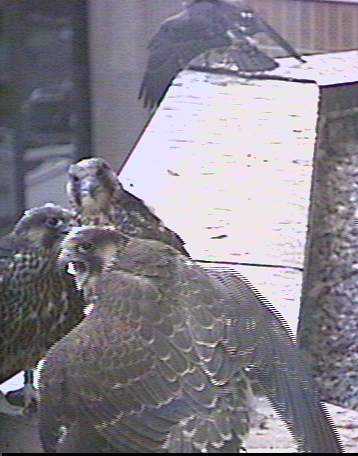
June 21, 2005 - Falconwatch Coordinator Lee Roy reports: The chicks remained fairly inactive for most of the day - it seemed as though yesterday's action was enough for them. While it appeared that Harvard had a very short flight on Monday, it was difficult to confirm. A local watcher has advised that he caught the brief foray on video, so yesterday we had 2 flights - both males, Canso and Harvard, were airborne!!!
With today being the longest day of the year the fledglings decided that they would take advantage of the extra light. At 17:35 one of the chicks left the ledge (this image was captured seconds before he took off from the far end), followed by a second at 17:58 and finally a third close to 18:15. The youngest chick stayed on the ledge. There was pandemonium on the ground as falconwatchers scrambled to locate all the birds. The three were located fairly quickly, but they did not stay in the same places for long. At dusk it appeared that one was spending the night on Copps Coliseum.

June 20, 2005 - Falconwatch Coordinator Lee Roy reports: He can fly!!! Today was an adventurous day for Canso. He took flight - unbeknownst to falconwatchers - just after 7 this morning. This picture was captured just seconds before the flapping Canso left the ledge. He was first noticed missing around 9:15 and was located an hour and a half later when a passer-by spotted him on the Convention Center roof. Around 14:30 he flew to the new Art Gallery of Hamilton 'AGH' sign and spent the heat of the day asleep under the 'G' - right over King Street!!. While on the sign the adults fed him twice and he was harassed by gulls.
Close to 19:00 Canso decided that the Convention Center roof and the Fairclough building were more to his liking and he flew from one to the other, then back again. Finally, at 19:30, Canso decided to try to cross back over to the Sheraton. He flew west on King Street and ended up on the eastern windows of the Standard Life building. There he hung on to a very tiny ledge by his toe nails (literally), eventually falling to the ground to the surprise of people waiting for the bus. Fortunately for Canso the rescue team was standing by. He was given a physical and, since his only injury was pride, he was released back on the roof of the Sheraton Hotel. By dusk he had made his way to the TV camera beam close to the ledge, and not long after made the short crossing into the ledge to join his nest mates. For a falcon that has only just started to fly Canso appears quite steady. It won't take him long to become a graceful and elegant bird. Now we'll see what tomorrow brings!
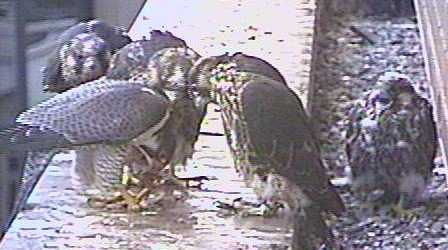
June 19, 2005 - Falconwatch Coordinator Lee Roy reports: While the Canadian Warplane Heritage's Lancaster bomber could be seen flying over Hamilton today, its Peregrine chick namesake and her siblings remained grounded. Canso came closest to a real flight when he hopped over his bother, who was also on the 'runway'. This picture, captured at 10:48 today, shows Newbie distributing a meal. The chick on the right is letting the others know she wants some too.
The adults are lessening the number of feedings and are trying to get the chicks to follow them for food. Both Madame X and Newbie were observed bringing food to the ledge and then leaving with the food to rest on a perch close by. They each made several passes at the nest to give the chicks the idea of what to do. It won't be long now!
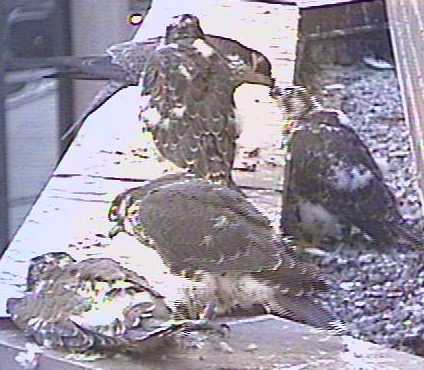
June 18, 2005 - Falconwatch Coordinator Lee Roy reports: As down feathers drifted to the ground there was more and more flapping and stretching by the chicks. All that exercise will help build muscles and make the first flight a safe one.
Yesterday both chicks and falconwatchers got a lesson in territorial activity when Madame X and Newbie took off together to drive away a Turkey Vulture. The Vulture, which was minding its own business as it flew over the downtown area, got quite a surprise when these two buzz-bombs arrived and made clear that it wasn't wanted. Why Peregrines consider Turkey Vultures to be a threat is not known, but they do!
The youngest member of the clutch is coming along well. Today she 'played' tug-o-war over a scrap of food with her older brothers, and she won! Well, at least for a little while. In the end they wound up sharing it. Madame X had a heart to heart with her youngest offspring while feeding her for almost 20 minutes on her own around 8:15PM, just after the image above was taken.
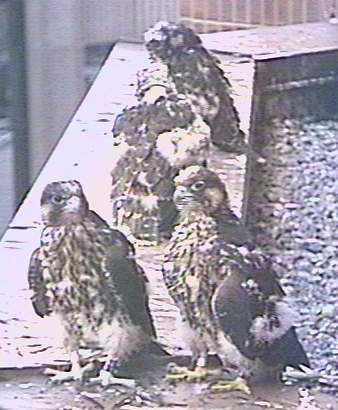
June 17, 2005 - Falconwatch Coordinator Lee Roy reports: It seems as if the chicks are just biding time until they fly. The male chick with the most brown feathering (we think it is Canso) has been teasing us for the past couple of days, flapping hard, running up and down the ledge and once even lifting a couple of inches off the 'ground'. He will likely be the first to fly.
These youngsters are beginning to get rebellious! Madame X was chased off the ledge today by one of the chicks when she failed to deliver food! The three larger chicks have been tugging and arguing over pieces of food left in the scrape. The youngest member of the family has been staying out of the way, even during feeding time, which can get quite boisterous. Have no worries though, the chick is being fed and will catch up in to its nest mates in no time. This picture of all four bundles of feathered mischief on the ledge was captured at 12:42 on June 16.
June 16, 2005 - Falconwatch Coordinator Lee Roy reports: Today was a quiet day for all six falcons. This morning's rainy weather stimulated the chicks to preen and pluck out more down feathers. They spent a good portion of the day grooming themselves and each other. There were fewer feedings than yesterday, as Newbie and Madame X stayed out of the rain and hunkered down for the day, but at dusk they delivered a bedtime snack to the chicks. One of them is going to fly soon, perhaps this weekend.
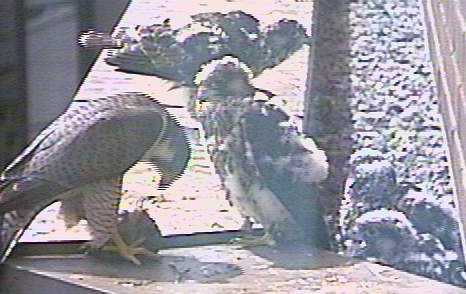
June 14, 2005 - Falconwatch Coordinator Lee Roy reports: Neither the sights of Hamilton nor heavy thunderstorms seemed to scare the fourth chick today. It got up on the ledge and hung out with its nest mates for quite a while. Around 6 o'clock this morning Madame X fed the chicks a large meal, possibly a duck, for over 20 minutes - a typical feeding usually takes about five minutes. She then flew off with the rest of the meal so that she and Newbie could have what was left. In total the chicks were fed 11 times today, almost double the number of times they were fed yesterday! This image, captured at 15:28 today, shows Newbie 'processing a catch' for the youngsters. This brood is growing fast, so don't be surprised that the youngsters look bigger today than they did just 24 hours ago.
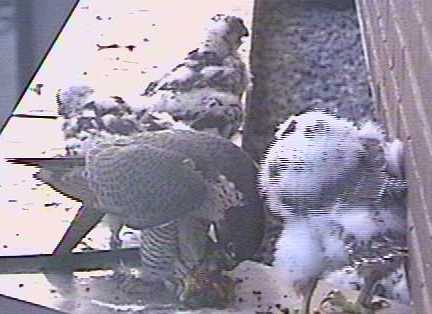
June 14, 2005 - Falconwatch Coordinator Lee Roy reports: And now there are four! Today the fourth chick got up on the ledge for a quick view of the area, and then decided it may be safer in the scrape. There is still much flapping on the ledge and even some running. It won't be long now before the first bird, likely a male, is in the air. We expect the first flight early next week, maybe even this weekend! This image of Madame X feeding the chicks was taken Sunday evening at 7PM. It gets crowded up there.
This evening, to the delight of the falconwatchers, Newbie and Madame X were seen soaring on the air currents brought in with the storm. What a beautiful sight! The chicks on the ledge watched and called out to their parents. It was as if the adults were showing them what they will be doing before too long.
June 13, 2005 - Falconwatch Coordinator Lee Roy reports: It seems that at least one of our chicks is part Nighthawk. Last night it was almost midnight before one of them settled down; it just paced up and down the ledge in the dark. Maybe this teenybopper wanted in on Hamilton's nightlife?
Today Newbie took a flight over the scrape on his way to hunt and from ground level all the chicks could be heard calling out. I'm certain I heard "Daddy! Daddy! We're hungry." Shortly he returned with a meal for his growing brood. In the afternoon Madame X provided the watchers with a bit of a scare when she decided to roost on a lightning rod just as a strong thunderstorm was ending, but with lightning still touching down in the area! What an electrifying place to dry off after a storm!!
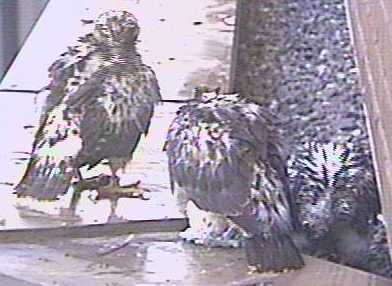
June 12, 2005 - Falconwatch Coordinator Lee Roy reports: First there were two, then one, then two again, and finally three. These little fluffs were up and down all day, except when they were asleep. All four chicks seem to be growing over night. Each day there seems to be less down and more feathers. To meet the demands of the growing chicks Madame X and Newbie are keeping the chicks well fed. Again today they were seen several times dropping food in the scrape as well as feeding the chicks on the ledge. This image, captured at 09:40 today, shows how much darker the birds have become in just 24 hours.
June 11, 2005 - Falconwatch Coordinator Lee Roy reports: Although the watch hasn't officially started, the falcons are giving us lots to look at. There has been a lot of flapping and jumping up on the ledge. Today the chicks were brought food and left alone with it, and they seemed to know just what to do. Around eight PM Falconwatchers were given a real treat, getting to see three chicks up on the ledge while Newbie fed them. The fourth tried to get up, but had difficulties. It won't be long before all four are up and flapping around.
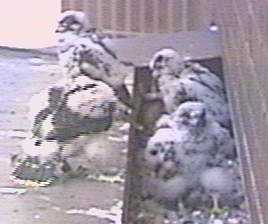
Last evening's thunderstorm brought some breezy relief to the day's sweltering heat. The young birds were eager to feel the 'wind in their hair', as it were. Two of them spent the better part of the evening up on the ledge. For a brief period a third chick joined the party. The male chick with the most developed dark feathering gave us a taste of things to come by doing some serious wing flapping up on the ledge.
Madame X and Newbie stayed close by and catered the event. The two bolder youngsters are being fed on the ledge. (This image was captured at 09:49 today - how would you like to have to feed this brood?) Being well fed also keeps the young birds hydrated as Peregrines get their water intake from the food they eat. The young birds really flop out and sleep away the hottest part of the day. On several occasions passersby asked whether the chicks were okay because when they are flat out it is hard to believe that they are just fine. Peregrines are intense birds - when they go, they go really fast; when they are doing nothing, they do it very well! A lesson to be learned for Falconwatchers to cope with the heat.
There is no doubt that this bunch are quick learners, but they may be part nighthawk. They just don't want to settle back down into the nest for the night, staying out on the ledge after 9:30 PM. Oh well they are at that awkward age - sleep all day, party all night!
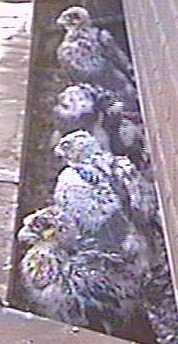
June 10, 2005: This is the first year since the Peregrines arrived in Hamilton that a mostly white, down-covered chick has gotten up on the ledge. Not only that, but last evening two of them were up there! This is the trickiest time in the youngsters' fledging period, designed by Nature to give fits to Falconwatchers. This picture, taken at 06:25 this morning after the thunderstorms had passed by, shows how dark the chicks' feathers have turned in only a couple of days. Several days earlier than planned, Falconwatch 2005 is underway, with dawn to dusk coverage of the nest site. A few more volunteers are required to assist in keeping an eye on the birds between now and approximately the end of June. Anyone interested in helping out can contact us by email at: falconwatch@hwcn.org
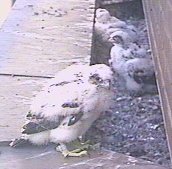
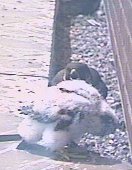

June 8, 2005: The first brave chick hopped up onto the ledge at 9:25am, and stayed there for about three minutes. This performance was repeated two more times today, at 2:21pm and 6:39pm, as seen above.
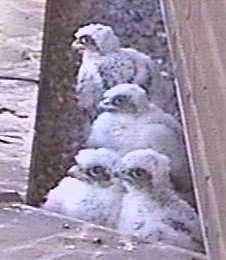
June 6, 2005: This image, taken at 06:50 today, shows how quickly the chicks are growing, not only in size but also in the feather department. The downy fluff we have been seeing for several weeks is being replaced with real brown feathers. This is most noticeable when a chick turns sideways to the camera and a dark wing line can be seen. The Hamilton Community Peregrine Project is gearing up for Falconwatch 2005, which should start in a week to ten days. Volunteers will be on site from dawn to dusk, keeping an eye on the birds in case any of them get into difficulty.
June 4, 2005: Madame X and Newbie stayed close to home today just to make sure those humans didn't come back! Madame X was down in the nest ledge with the chicks many times Thursday, almost as if she was counting heads. Today she stayed on nearby perches while Newbie took a characteristic pose on the very top of the Sheraton 't'. At this point in the chicks' development you can practically watch them grow. In between naps they practice galloping from one end of the gravel to the other on their newly found feet. At this ungainly and awkward stage it is hard to believe how soon they will be streamlined graceful flying machines.
This year, the 60th anniversary of the end of World War Two, HCPP members felt it particularly fitting to name a brood of Hamilton Peregrines after other impressive flyers that shared their home town airspace during that war.
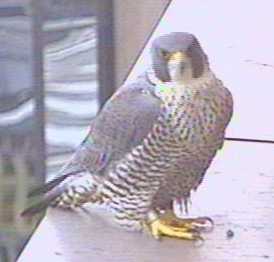

The largest female chick was named Lancaster after probably the most famous Allied bomber of World War II. The 'Lanc' was known for its impressive flying characteristics and operational performance, something that can be said about most of the Peregrines we know. Thousands of Canadian aircrew and other personnel served with Royal Canadian Air Force and Royal Air Force Lancaster squadrons in England. At home thousands of Canadians worked for Victory Aircraft in Malton (Toronto), Ontario, where over 400 Lancaster Mk X's were produced. Of the more than 7300 Lancasters that rolled off production lines in Britain and Canada, only two still fly and one of them is located right here in Hamilton. It turns out that our Peregrine Lancaster really is her mother's daughter. Unknown to HCPP prior to yesterday's naming, a Malton-built Lancaster airplane, part of 428 Ghost Squadron, was named Madam X. Above are pictures of Madame X 2005 and Madam X, circa 1944.
The Anson, or 'Faithful Annie' as she was known to her admirers, is the namesake for the second female chick of this year's brood. Built in Britain as a reconaissance airplane for the RAF, the Anson began military service in 1936. In Canada the Anson is best known for its employment in the British Commonwealth Air Training Plan. Used as a trainer, the Anson quickly became the mainstay of the plan that graduated many of the pilots who would fly multi-engined aircraft for the RCAF and RAF. Ansons rendered excellent service to the RCAF until the last one was retired in 1954. Canadian built Ansons had a number of parts manufactured in this area, some by Cockshutt Manufacturing in Brantford.
The older of the two male chicks was named for the 'Canso A', adopted in 1939 by the RCAF as an amphibious first cousin to the Catalina flying boat. Cansos were widely distributed during WW2 and proved instrumental in protecting Transatlantic convoys heading to England. It has been described as a graceful bird riding the wind with smooth elegant flair.
Our younger male Peregrine is Harvard. The Harvard airplane, named after the university, was used to train thousands of Commonwealth pilots for combat flying in fighters and fighter-bombers. An admirable training aircraft, the Harvard saw service at Centralia and Trenton training schools and was kept on strength as a trainer by the RCAF until 1966.
All of the planes chosen as Peregrine namesakes are on display at the Canadian Warplane Heritage (CWH) Museum at Hamilton Airport in Mount Hope. The Lancaster, Harvard and Canso still fly on a regular basis. The Anson is currently under restoration and CWH hopes it will fly again within the next few years. HCPP volunteers know that we won't have to wait that long to see 'Faithful Annie' take to the air downtown at the Sheraton. Many thanks to Chad Martin, Curator of the CWH Museum, for information on the aircraft and his insightful interpretive comments. For more information on CWH and its planes, go to: http://www.warplane.com/
June 3, 2005: LANCASTER, ANSON, HARVARD and CANSO were introduced to Hamilton and the world yesterday and did very well. The two males and two females are healthy, weigh nicely in the ranges for their gender, and are certainly feisty. Mother Madame X was again all over the place looking out for her chicks, even settling down on the ledge to give the climber a lengthy piece of her mind. More details later. To see photos of yesterday's activity, click on 'Gallery', then 'Full Webcam Archive', select the 10:00AM-11:59AM group for yesterday (June 2) and work through the images.
June 2, 2005: In a few hours the chicks will meet the world face to face. This image, captured at 20:27 last evening, shows the young ones getting some late day rays during a beautiful warm spring sunset. They continue to grow by leaps and bounds, and regular watchers will notice that some of their dark wing feathers have started to appear.
May 31, 2005: Although the chicks don't know it yet, Thursday, June 2, will be a big day for them. First a strange creature - a human - is going to drop down out of the sky onto the ledge. Then they will be placed in a big padded box, each in a separate compartment, and taken inside the Sheraton where other humans will be waiting. After being weighed, banded, and photographed the chicks will be returned to the nest ledge and their anxious parents. The climber will also remove the big weed that has grown in the ledge and started to obscure views of the birds. These activities are expected to begin around 10AM, so if on Thursday morning you see a pair of legs drop into the picture at left or someone sitting on the ledge, don't be concerned. In keeping with HCPP tradition the young Peregrines will be given names of historical significance, usually with a distinct Hamilton focus. These will be announced after the banding. When the chicks start to fly, in two weeks or so, the names will be very useful for the Falconwatch volunteers who monitor them.
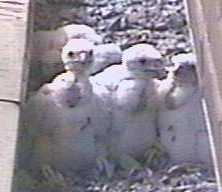
May 28/29, 2005: (The chicks have decided that they like the ledge corner nearest the camera, which sometimes makes them hard to see. They are there - just watch what happens when the adults bring in food.) What a difference a week makes! This image, captured at 1525 Friday, May 27, shows how much the chicks - three of them quite alert and the fourth dozing - have grown since the picture below. If all goes well banding should take place late next week and then we will have an idea of how many males and/or females we have in the nest. Check the Webcam Favorites, in the Gallery, for more pictures. Click on the History button for recent news about Dundas (2004) and Jackson (2003).
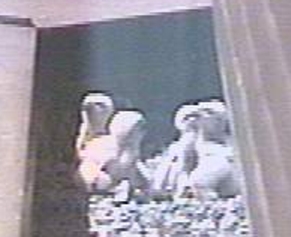
May 23, 2005: Things seem to be going very well for the young Sheraton Hamilton Peregrines, although they must be wondering if it ever really gets warm in Hamilton. This picture, captured at 13:17 Thursday, May 19, is the first to distinctly show all four chicks. They are growing like bad weeds! (And yes, that is a real weed growing in the corner of the big picture opposite - we will have to get the gardener to tidy things up!) As they did in the incubation period, Madame X and Newbie are sharing brooding duties. Food is obviously in good supply too. On Friday Madame X was seen leaving the nest with the remains of a meal and just a few seconds later Newbie arrived with fresh food. What a team!!!
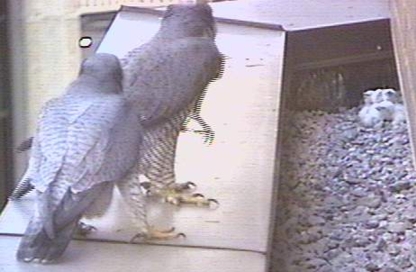
May 13, 2005: At 06:15 this morning Madame X and Newbie were on the ledge looking down at what appeared to be four very healthy chicks! The adults' body language suggested that they were thinking, "Not again?"
UPDATE: May 11, 2005 - 2:54PM: And then there were two!
May 11, 2005: At 05:43 this morning there was a hint that a chick might have arrived overnight. At 08:23 Madame X shuffled around a bit and there was no doubt! At least one young Peregrine is in the nest.
May 5, 2005: This spring's cold weather may delay things a bit, but if last year's hatching dates are anything to go by, we could be seeing little white fluffballs sometime this weekend.
May 1, 2005: If Peregrines were to 'think' like people it would be easy to write in cartoon thought bubbles for Madame X and Newbie as they incubate their eggs. Like most Hamiltonians it would probably have something to do with the weather! One day it's hot, the next day there's frost and potentially even some wet snow thrown into the mix, like last weekend! Given the lengthy brood period (30 to 35 days) and the quantum leap the hatchlings have to make from egg to independence in one short summer, Peregrines have to get an early jump on the breeding season. Consequently, the adult birds are physically equipped to face the elements as they endure the vagaries of spring. Their thick coat of feathers keeps them insulated and dry as they devotedly shelter the clutch of eggs.
Newbie is doing equal time (at least!) on the nest and Madame X is obviously pleased with this arrangement as she often disappears from view while he is brooding. On the other hand, while Madame X is home Newbie doesn't stray too far afield. He can often be seen standing point guard from the roof of the Stelco Tower or other lofty spots within easy diving range of the nest site.
April 23, 2005: We have just received word that Stelco, one of the chicks hatched in 1997, is alive and well and brooding eggs in Lansing, Michigan. For more on Stelco click on the history tab and look for a picture in the Gallery.
Things are pretty quiet at the Sheraton. The adults are coping with the cold temperatures and the recent rain. Several people have asked how we tell the adult birds apart. While it can often be difficult, again this year it is fairly straightforward. A characteristic of Peregrines is the 'malar' stripe, the dark marking on their cheek below the eye ahead of the white patch. Once Peregrines reach adulthood these stripes are well defined and usually remain more or less the same year after year, even as old feathers are molted, i.e. replaced by new ones. Watch for the birds to present a clear profile when on the ledge or in the scrape. Madame X has a very large triangular malar stripe, with a relatively small white area behind it. Newbie's, on the other hand, is rectangular and very narrow, so the white patch is large.
April 15, 2005: A clear look at the nest site around 14:22 yesterday provided a nice picture of four very distinct (and large!) eggs. Whether or not there will be any more is not known. If timing is similar to previous years, we should be seeing little white balls of fluff around May 10 - 11. Keep checking this space!
April 13, 2005: We have just learned that around 12:30 Sunday afternoon an Internet Falconwatcher noticed that the nest was temporarily adult-less and thought there were four eggs. A close look at the pictures confirms three eggs and almost certainly four. Could there be more? Keep checking this space!
April 12, 2005: All is peaceful at the Sheraton nest site as the Peregrine parents-to-be, Madame X and Newbie, settle in for the long wait. Newbie is content to share the incubating duties with Madame X, spending about equal time brooding the clutch of eggs. The recent cold nights settled the adults into full time brooding, allowing us very few peeks to count eggs! Viewers at the Jay set public monitor are always tickled to see a 'shift change' between adults so they can get a look at the scrape. When you see how vigorously the adult birds roll the eggs around in the scrape to ensure equal incubation for all, it's easy to understand how the eggshell thinning effects of DDT could have had such significant impact on the reproductive success of peregrines.
April 5, 2005 - The horrible weather over the weekend did not stop Madame X from laying two eggs (at last count). Today she and Newbie took turns brooding the eggs, with Newbie spending more time in this role than most male Peregrines normally do. Madame X has a history of laying four eggs so the egg watch continues. If all goes well there should be chicks in the nest by mid-May. Stay tuned! [NEWS from away - Jackson, one of the 2003 chicks, has just been identified as the new male at the St. Lawrence Cement Plant nest in Mississauga. Click the HCPP History page button above for more on him.]
April 2, 2005 - Everyone has been busy around the Sheraton Hamilton Hotel. On Friday HCPP members restarted the TV camera and installed the monitor in the Jay Set store in Jackson Square Shopping Centre (near the King Street entrance to the Thompson Building). Our Webmaster is setting up a new computer that will allow us to activate the Webcam in a few days. For their part, the birds have been very active. Within a couple of minutes of turning on the monitor (How do they know?) Madame X was in the scrape, which appears to be deeper even than it was last year. In the last few days Madame X and Newbie have been seen in courtship activities on the nest ledge, on various buildings and even atop the antenna high above the Fairclough building! Everyone is waiting for the first sign of egg-laying and hoping that the birds will delay it at least until after the current snow and rain storm passes by. Watch this space!
March 22, 2005 - The adult Peregrines spent the winter of 2004-2005 roosting on signs on the CIBC building. For the last week they have been busy at the Sheraton nest site. As far as we can tell at this time the birds are Madame X and Newbie, although we've been fooled before. They (and we) are pleased that most of the construction work across the street at the Art Gallery of Hamilton has been finished. On Saturday, March 19 the birds were observed mating. On Sunday the 20th they were courting, with Newbie bringing food to Madame X, so eggs can't be far behind. Stay tuned for the live Webcam.
In 2004 Madame X and Newbie hatched and successfully fledged four chicks - Cootes, Macassa and Macnab, all female, and Dundas, the only male, fledged successfully. Sometime during the fall of 2004 Dundas lost a leg but this has not slowed him down much. In late February 2005 he was filmed by a CHTV Videographer as he 'processed' a recently captured meal.
Madame X was born on a bridge on Pennsylvania Route 309, the Cross-Valley Expressway in Wilkes-Barre, Luzerne County, Pennsylvania. Banded as a hatchling on 7, June 1999 she was known to the falcon watchers in Northeast PA as 'Runaround Sue', a name suggested after she was found running along the expressway guide wall one morning. We are keeping the folks in Pennsylvania posted on Madame X's progress. Because Newbie has no bands it will be almost impossible to identify him.
Many birds exhibit a trait called 'site fidelity'. If at least one of a pair that used a nest site in the previous year return, and if there have been no significant physical changes to disturb either the nest itself or the birds generally, they will use the same nest site over and over again, year after year. Peregrine Falcons are known for site fidelity. This will be Madame X's fifth year in Hamilton and Newbie's third.
 |
Web page created by
Charles Gregory